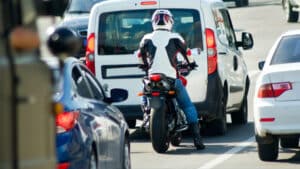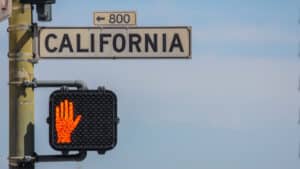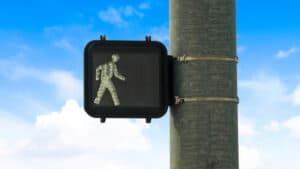West’s Annotated California Codes
Division 11. Rules of the Road
Chapter 5. Pedestrians’ Rights and Duties
§ 21949. Legislative findings and declarations; pedestrian travel and access
(a) The Legislature hereby finds and declares that it is the policy of the State of California that safe and convenient pedestrian travel and access, whether by foot, wheelchair, walker, or stroller, be provided to the residents of the state.
(b) In accordance with the policy declared under subdivision (a), it is the intent of the Legislature that all levels of government in the state, particularly the Department of Transportation, work to provide convenient and safe passage for pedestrians on and across all streets and highways, increase levels of walking and pedestrian travel, and reduce pedestrian fatalities and injuries.
§ 21950. Right-of-way at crosswalks
(a) The driver of a vehicle shall yield the right-of-way to a pedestrian crossing the roadway within any marked crosswalk or within any unmarked crosswalk at an intersection, except as otherwise provided in this chapter.
(b) This section does not relieve a pedestrian from the duty of using due care for his or her safety. No pedestrian may suddenly leave a curb or other place of safety and walk or run into the path of a vehicle that is so close as to constitute an immediate hazard. No pedestrian may unnecessarily stop or delay traffic while in a marked or unmarked crosswalk.
(c) The driver of a vehicle approaching a pedestrian within any marked or unmarked crosswalk shall exercise all due care and shall reduce the speed of the vehicle or take any other action relating to the operation of the vehicle as necessary to safeguard the safety of the pedestrian.
(d) Subdivision (b) does not relieve a driver of a vehicle from the duty of exercising due care for the safety of any pedestrian within any marked crosswalk or within any unmarked crosswalk at an intersection
§ 21950.5. Removal of crosswalk; notice
(a) An existing marked crosswalk may not be removed unless notice and opportunity to be heard is provided to the public not less than 30 days prior to the scheduled date of removal. In addition to any other public notice requirements, the notice of proposed removal shall be posted at the crosswalk identified for removal.
(b) The notice required by subdivision (a) shall include, but is not limited to, notification to the public of both of the following:
(1) That the public may provide input relating to the scheduled removal.
(2) The form and method of providing the input authorized by paragraph (1).
§ 21951. Vehicles stopped for pedestrians
Whenever any vehicle has stopped at a marked crosswalk or at any unmarked crosswalk at an intersection to permit a pedestrian to cross the roadway the driver of any other vehicle approaching from the rear shall not overtake and pass the stopped vehicle.
§ 21952. Right-of-way on sidewalk
The driver of any motor vehicle, prior to driving over or upon any sidewalk, shall yield the right-of-way to any pedestrian approaching thereon.
§ 21953. Tunnel or overhead crossing
Whenever any pedestrian crosses a roadway other than by means of a pedestrian tunnel or overhead pedestrian crossing, if a pedestrian tunnel or overhead crossing serves the place where the pedestrian is crossing the roadway, such pedestrian shall yield the right-of-way to all vehicles on the highway so near as to constitute an immediate hazard.
This section shall not be construed to mean that a marked crosswalk, with or without a signal device, cannot be installed where a pedestrian tunnel or overhead crossing exists.
§ 21954. Pedestrians outside crosswalks
(a) Every pedestrian upon a roadway at any point other than within a marked crosswalk or within an unmarked crosswalk at an intersection shall yield the right-of-way to all vehicles upon the roadway so near as to constitute an immediate hazard.
(b) The provisions of this section shall not relieve the driver of a vehicle from the duty to exercise due care for the safety of any pedestrian upon a roadway.
§ 21955. Crossing between controlled intersections
Between adjacent intersections controlled by traffic control signal devices or by police officers, pedestrians shall not cross the roadway at any place except in a crosswalk.
§ 21956. Pedestrian on roadway
(a) No pedestrian may walk upon any roadway outside of a business or residence district otherwise than close to his or her left-hand edge of the roadway.
(b) A pedestrian may walk close to his or her right-hand edge of the roadway if a crosswalk or other means of safely crossing the roadway is not available or if existing traffic or other conditions would compromise the safety of a pedestrian attempting to cross the road.
§ 21957. Hitchhiking
No person shall stand in a roadway for the purpose of soliciting a ride from the driver of any vehicle.
§ 21958. Repealed by Stats.1969, c. 207, p. 490, § 1
§ 21959. Skiing or tobogganing
It is unlawful for any person to ski or toboggan on or across any roadway in such a manner as to interfere with the movement of vehicles thereon. A person on skis proceeding on or across a highway at a pace no greater than a walk is not within the prohibition of this section and shall be considered to be a pedestrian with all the rights and duties thereof as prescribed in this code.
§ 21960. Freeways and expressways
(a) The Department of Transportation and local authorities, by order, ordinance, or resolution, with respect to freeways, expressways, or designated portions thereof under their respective jurisdictions, to which vehicle access is completely or partially controlled, may prohibit or restrict the use of the freeways, expressways, or any portion thereof by pedestrians, bicycles or other nonmotorized traffic or by any person operating a motor-driven cycle, motorized bicycle, or motorized scooter. A prohibition or restriction pertaining to bicycles, motor-driven cycles, or motorized scooters shall be deemed to include motorized bicycles; and no person may operate a motorized bicycle wherever that prohibition or restriction is in force. Notwithstanding any provisions of any order, ordinance, or resolution to the contrary, the driver or passengers of a disabled vehicle stopped on a freeway or expressway may walk to the nearest exit, in either direction, on that side of the freeway or expressway upon which the vehicle is disabled, from which telephone or motor vehicle repair services are available.
(b) The prohibitory regulation authorized by subdivision (a) shall be effective when appropriate signs giving notice thereof are erected upon any freeway or expressway and the approaches thereto. If any portion of a county freeway or expressway is contained within the limits of a city within the county, the county may erect signs on that portion as required under this subdivision if the ordinance has been approved by the city pursuant to subdivision (b) of Section 1730 of the Streets and Highways Code.
(c) No ordinance or resolution of local authorities shall apply to any state highway until the proposed ordinance or resolution has been presented to, and approved in writing by, the Department of Transportation.
(d) An ordinance or resolution adopted under this section on or after January 1, 2005, to prohibit pedestrian access to a county freeway or expressway shall not be effective unless it is supported by a finding by the local authority that the freeway or expressway does not have pedestrian facilities and pedestrian use would pose a safety risk to the pedestrian.
§ 21961. Local regulation of pedestrians
This chapter does not prevent local authorities from adopting ordinances prohibiting pedestrians from crossing roadways at other than crosswalks.
§ 21962. Pedestrian on bridge
Any peace officer having reasonable cause to believe that any pedestrian is stopped or standing on any bridge or overpass for the purpose of violating Section 23110, may lawfully order such person from the bridge or overpass.
§ 21963. Visually handicapped pedestrian
A totally or partially blind pedestrian who is carrying a predominantly white cane (with or without a red tip), or using a guide dog, shall have the right-of-way, and the driver of any vehicle approaching this pedestrian, who fails to yield the right-of-way, or to take all reasonably necessary precautions to avoid injury to this blind pedestrian, is guilty of a misdemeanor, punishable by imprisonment in the county jail not exceeding six months, or by a fine of not less than five hundred dollars ($500) nor more than one thousand dollars ($1,000), or both. This section shall not preclude prosecution under any other applicable provision of law.
§ 21964. White canes
No person, other than those totally or partially blind, shall carry or use on any highway or in any public building, public facility, or other public place, a predominantly white cane (with or without a red tip).
§ 21965. Definitions
As used in Sections 21963 and 21964, “blind,” “totally blind,” and “partially blind,” mean having central visual acuity not to exceed 20/200 in the better eye, with corrected lenses, as measured by the Snellen test, or visual acuity greater than 20/200, but with a limitation in the field of vision such that the widest diameter of the visual field subtends an angle not greater than 20 degrees.
§ 21966. Pedestrian in bicycle lane
No pedestrian shall proceed along a bicycle path or lane where there is an adjacent adequate pedestrian facility.
§ 21967. Skateboards on highways, sidewalks or roadways
Except as provided in Section 21968, a local authority may adopt rules and regulations by ordinance or resolution prohibiting or restricting persons from riding or propelling skateboards on highways, sidewalks, or roadways.
§ 21968. Motorized skateboards; propulsion restrictions on sidewalks, roadways, bikeways, etc.
No motorized skateboard may be propelled on any sidewalk, roadway, or any other part of a highway or on any bikeway, bicycle path or trail, equestrian trail, or hiking or recreational trail.
§ 21969. Roller skating on highways, sidewalks or roadways; adoption of rules and regulations by ordinance
A local authority may adopt rules and regulations by ordinance regulating persons engaged in roller skating on a highway, sidewalk, or roadway.
§ 21970. Vehicle blocking crosswalk or sidewalk; one-way streets
(a) No person may stop a vehicle unnecessarily in a manner that causes the vehicle to block a marked or unmarked crosswalk or sidewalk.
(b) Subdivision (a) does not preclude the driver of a vehicle facing a steady circular red light from turning right or turning left from a one-way street onto a one-way street pursuant to subdivision (b) of Section 21453.
§ 21971. Specified violations of sections 21451, 21453, 21950 or 21952 causing bodily injury; punishment
Notwithstanding any other provision of law, any person who violates subdivision (a) or (b) of Section 21451, subdivision (b) of Section 21453, subdivision (a) of Section 21950, or Section 21952, and causes the bodily injury of anyone other than the driver is guilty of an infraction punishable under Section 42001.18.
Current with legislation through Ch. 765 of the 2008 Reg.Sess., Ch. 1 of the 2007-2008 1st Ex.Sess., Ch. 1 of the 2007-2008 2nd Ex.Sess., Ch. 7 of the 2007-2008 3rd Ex.Sess., and all propositions on 2008 ballots.










